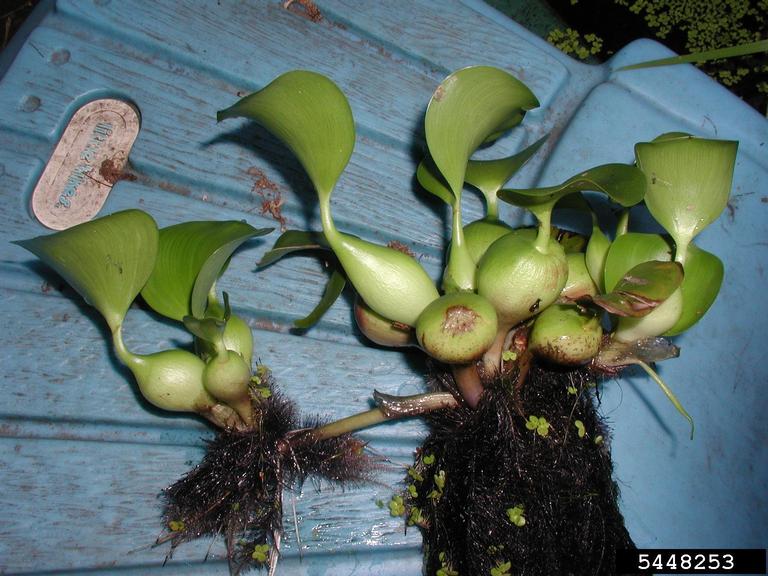Water Hyacinth

Water Hyacinth
(Eichhornia crassipes)
Priority: - Prevent / EDRR
Tags: Aquatic | EDRR
Identification and Reproduction
Identification:
- Water hyacinth is a free-floating aquatic plant that is frequently used as pond plants.
- Leaf blades are bright green, thick, glossy and are attached to an inflated leafstalk that is filled with spongy tissue. Individual leaves are kidney-shaped.
- Leaves are floating and grow to form a rosette.
- Roots are dark purple to black and will hang underwater beneath the rosette.
- Produces a flower spike composed of 4-15 individual flowers. Each flower is composed of 6 petals, purple to pink with the upper petal with a distinct yellow spot.
Reproduction:
- Reproduces by runners or stolons that extend to form daughter plants.
- Stolons can off shoot axillary buds that can be dispersed by water movement, wind and human activities.
- They also produce seeds that can remain viable for 28 years.
Habitat & Ecology
- This plant is widespread around tropical and subtropical regions.
- Thrives in shallow ponds, wetlands and marshs or slow flowing waterways, lakes and rivers.
- Plants can withstand seasonal water level fluctuations.
- Growth is accelerated in nutrient rich waters.
Impacts
Social:
- Large infestations will slow water flow and block irrigation canals.
- Will also disrupt recreational activities; boating, swimming and fishing.
Ecological:
- Water hyacinth grows and spreads rapidly under favourable conditions and forms dense floating mats that reach 2 m thick.
- Displaces and out-competes species for space, light and nutrients.
- Reduces oxygen levels in the water body, altering the plant, invertebrate and fish community. This often results in mass fish kill.
- It releases heavy metal and other pollutants into the water as it decomposes, reducing overall water quality.
- Creates a favourable habitat for mosquitoes.
Management
Prevention is a high priority for this plant.
- Do not plant or purchase this plant to put in your pond or water garden.
- Never release unwanted plants into natural waterbodies.
- Learn to identify this plant and avoid traveling through infested sites.
- Always clean, drain, and dry aquatic equipment like boats or canoes before transferring from one body of water to another.
- Please report any suspected plants.
Resources
For more details check out the Invasive Species Compendium datasheet on Eichhornia crassipes (water hyacinth).
Download the Invasive Species Council of Manitoba's factsheet on Water Hyacinth here.
Find more information in the NAISMA Water Hyacinth factsheet.
Header photo (Allan Fesalbon Castañeda)




